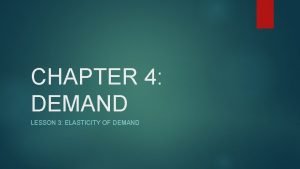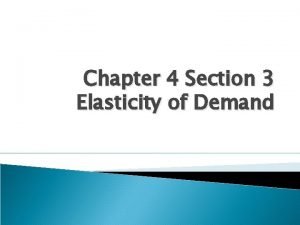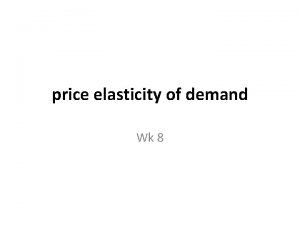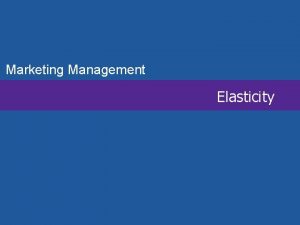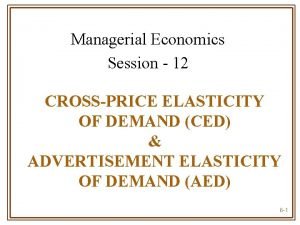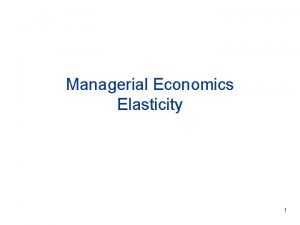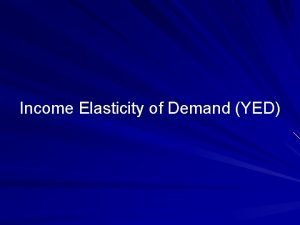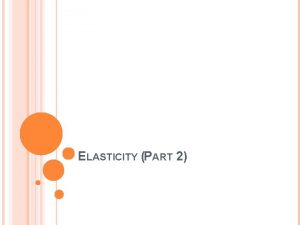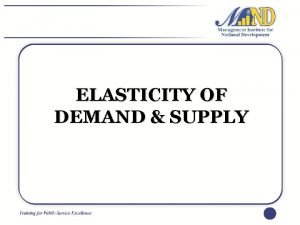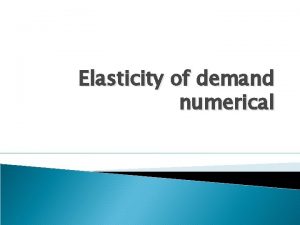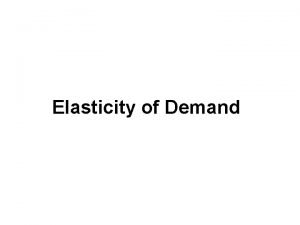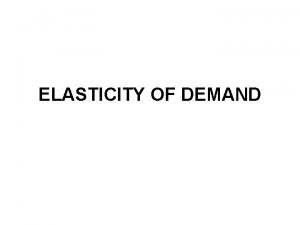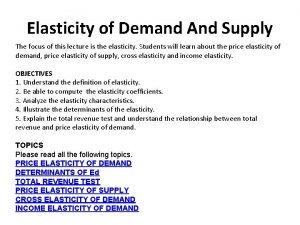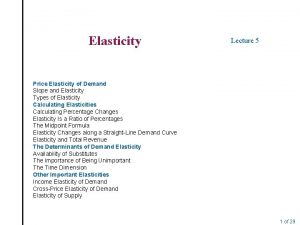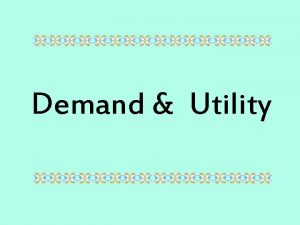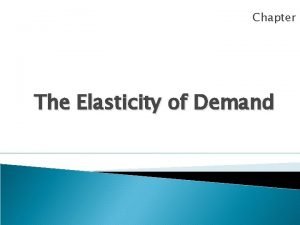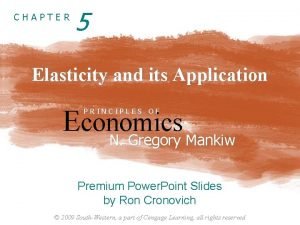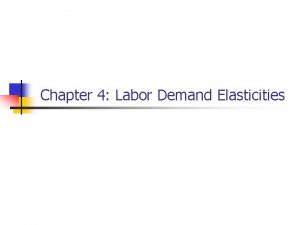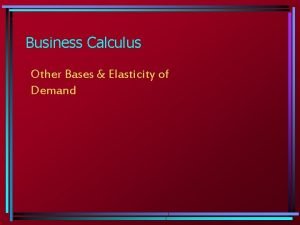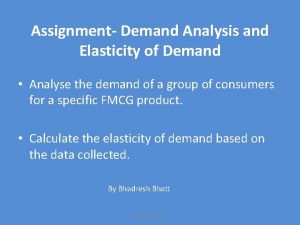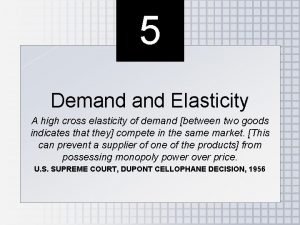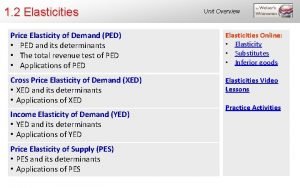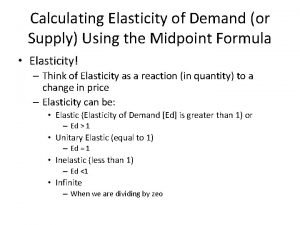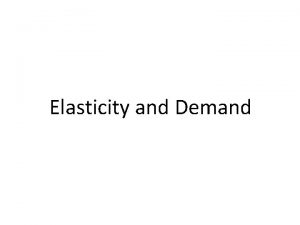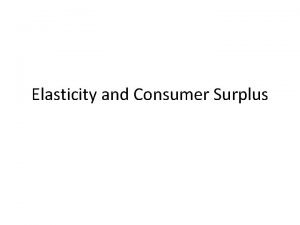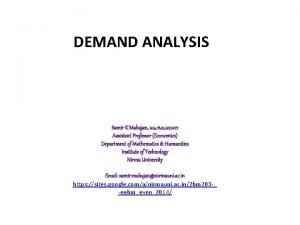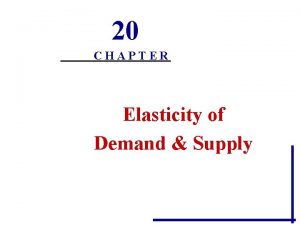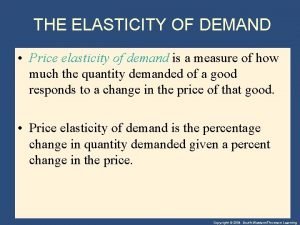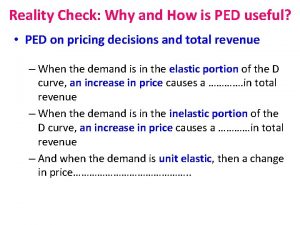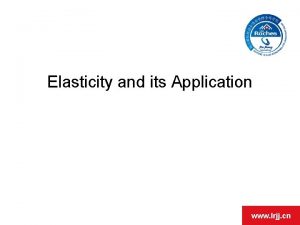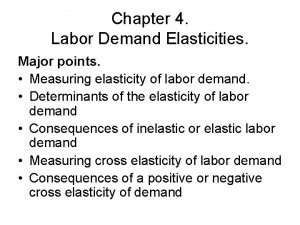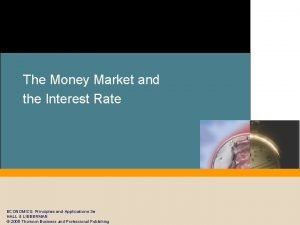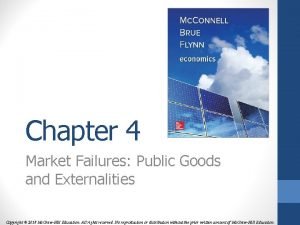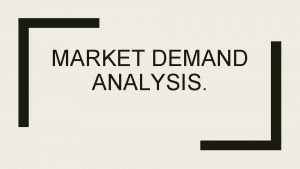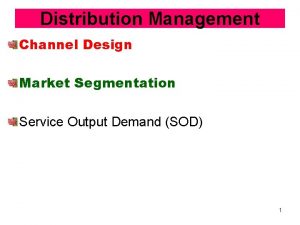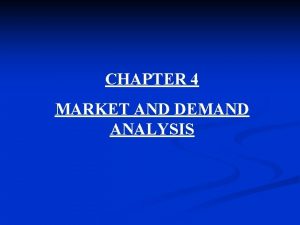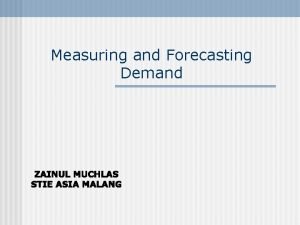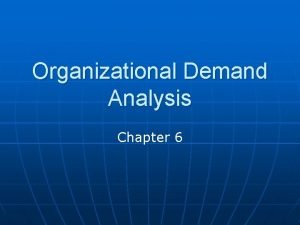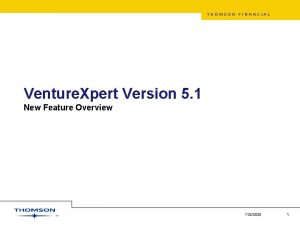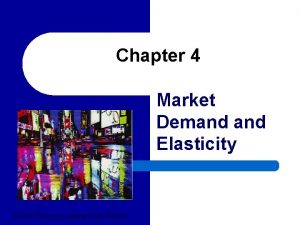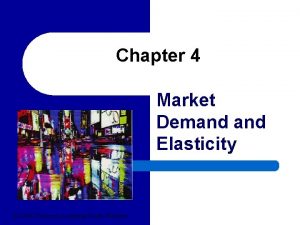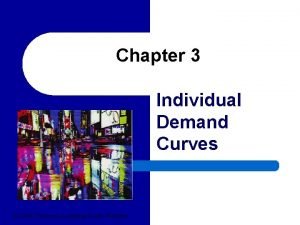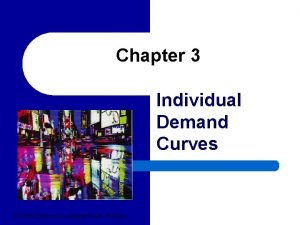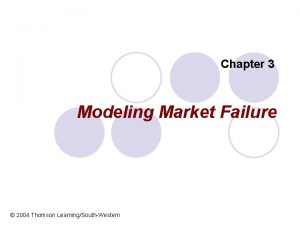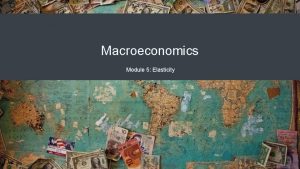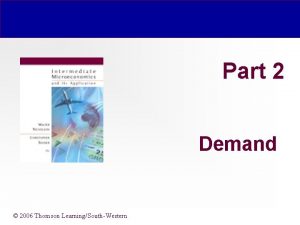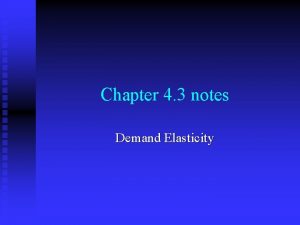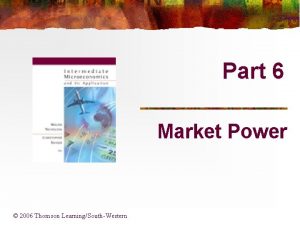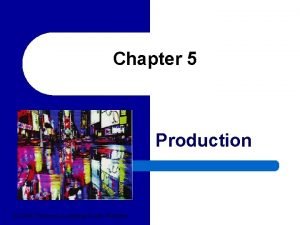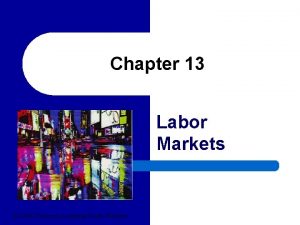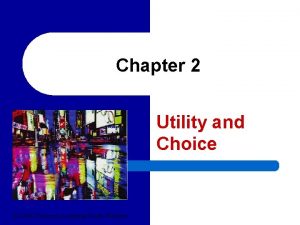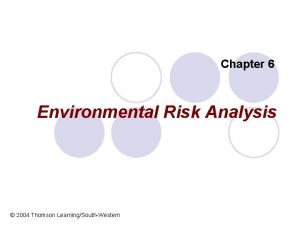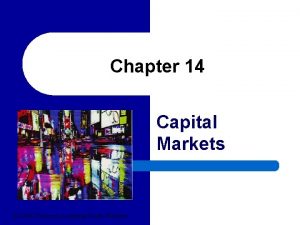Chapter 4 Market Demand Elasticity 2004 Thomson LearningSouthWestern







































































- Slides: 71

Chapter 4 Market Demand Elasticity © 2004 Thomson Learning/South-Western

Market Demand Curves l l 2 The market demand is the total quantity of a good or service demanded by all potential buyers. The market demand curve is the relationship between the total quantity demanded of a good or service and its price, holding all other factors constant.

Construction of the Market Demand Curve l l The market demand curve is constructed by horizontally summing the demands of the individual consumers Assume the market consists of only two buyers as shown in Figure 4. 1 – 3 At any given price, such as P*X, individual 1 demands X*1 and individual 2 demands X*2.

FIGURE 4. 1: Constructing a Market Demand Curve from Individual Demand Curves PX P* X 0 X* 1 (a) Individual 1 4

FIGURE 4. 1: Constructing a Market Demand Curve from Individual Demand Curves PX PX P* X 0 X* 1 (a) Individual 1 5 0 X* 2 (b) Individual 2

Construction of the Market Demand Curve – l l 6 The total quantity demanded at the market at P*X is the sum of the two amounts: X * = X *1 + X *2. The point X*, P*X is one point on the market demand curve. The other points on the curve are similarly plotted.

FIGURE 4. 1: Constructing a Market Demand Curve from Individual Demand Curves PX PX PX P* X D 0 X* 1 (a) Individual 1 7 0 X* 2 (b) Individual 2 0 X* X (c) Market Demand

Shifts in the Market Demand Curve l 8 To discover how some event might shift a market demand curve, we must first find out how this event causes individual demand curves to shift and then compare the horizontal sum of these new demand curves with the old demand curve.

Shifts in the Market Demand Curve l l l 9 For example consider the two buyer case where both consumers regard X as a normal good. An increase in income for each consumer would shift their individual demand curves out so that the market demand curve, would also shift out This situation is shown in Figure 4. 2

FIGURE 4. 2: Increases in Each individual’s Income Cause the Market Demand Curve to Shift Outward PX PX PX D P* X 0 X* 1 (a) Individual 1 10 0 X* 2 (b) Individual 2 0 X* X (c) Market Demand

FIGURE 4. 2: Increases in Each individual’s Income Cause the Market Demand Curve to Shift Outward PX PX PX D’ D P* X 0 X* X** 1 1 (a) Individual 1 11 0 X* X** 2 2 (b) Individual 2 0 X* X** X (c) Market Demand

Shifts in the Market Demand Curve l However, some events result in ambiguous outcomes. – l 12 If one consumer’s demand curve shifts out while another’s shifts in, the net effect depends on the size of the relative shifts. An increase in income for pizza lovers would increase the market demand for pizza so long as it is a normal good.

Shifts in the Market Demand Curve l l 13 On the other hand, if the increase in income was for people who don’t like pizza, there would be no significant effect on the market demand curve for pizza. Changes in the prices of related goods, substitutes or complements, will also shift the individual and market demand curves.

Shifts in the Market Demand Curve l l 14 If goods X and Y are substitutes, an increase in the price of Y will increase the demand for X. Similarly, a decrease in the price of Y will decrease the demand for X. If goods X and Y are complements, an increase in the price of Y will decrease the demand for X. A decrease in the price of Y will increase the demand for X.

APPLICATION 4. 1: Consumption and Income Taxes l l 15 People’s ability to purchased goods and services is dependent upon their after tax income. In the 1950’s Milton Friedman argued that people’s consumption decisions are based mostly on their long-term (permanent) income.

APPLICATION 4. 1: Consumption and Income Taxes l One implication of the permanent-income hypothesis is that temporary tax changes will have little effect on the demand for consumption goods – 16 This prediction is supported by the small impact on consumption by both the temporary tax surcharge during the Nixon administration and the Ford administration’s temporary income tax rebate

APPLICATION 4. 1: Why the 2001 Tax Cut Was a Dud l l l 17 In May 2001, Congress passed one of the largest cuts in personal income taxes in history. Our discussion of demand theory showed that changes in personal incomes shift demand curves outward. However, Milton Friedman viewed that spending decisions are based on a person’s “permanent” income.

APPLICATION 4. 1: Why the 2001 Tax Cut Was a Dud l l l 18 This insight suggests that the 2001 tax cut had little impact for two reasons. First, The $300 checks were too small to stimulate spending on any major goods, so they were largely saved. Second, Most of the tax cuts do not begin until 2006, and the largest cuts are reserved until 2009 -10.

A Word on Notation and Terms l l l 19 When looking at only one market, Q is used for the quantity of the good demanded, and P is used for its price. When drawing the demand curve, all non-price factors are assumed to not change. Movements along the curve are changes in quantity demanded, while shifts are changes in demand.

Elasticity l l 20 Goods are often measured in different units (steak is measured in pounds while oranges are measured in dozens). It can be difficult to make simple comparisons between goods when trying to determine which is more responsive to changes in price.

Elasticity l l 21 Elasticity is a measure of the percentage change in one variable brought about by a 1 percent change in some other variable. Since it is measured in percentages, the units cancel out so that it is a unit-less measure of responsiveness.

Price Elasticity of Demand l 22 The price elasticity of demand is the percentage change in the quantity demanded of a good in response to a 1 percent change in its price

Price Elasticity of Demand l l l 23 The price elasticity records how Q changes in percentage terms in response to a percentage change in P. Since, on a typical demand curve, P and Q move oppositely, e. Q, P will be negative. For example, if e. Q, P = -2, a 1 percent increase in price leads to a 2 percent decline in quantity.

Values of the Price Elasticity of Demand l l l 24 When e. Q, P < -1, a price increase causes more than a proportional quantity decrease and the curve is called elastic. When e. Q, P = -1, a price increase causes a proportional quantity decrease, and the curve is called unit elastic. When e. Q, P > -1, a price increase causes less than a proportional quantity decrease, and the curve is called inelastic.

TABLE 4. 1: Terminology for the Ranges of e. Q, P 25

Price Elasticity and the Shape of the Demand Curve l We often classify market demand curves by their elasticities – – 26 For example, the market demand curve for medical services is inelastic (nearly vertical) since there is little quantity response to changes in price. Alternatively, the market demand curve for a single type of candy bar is very responsive to price change (nearly flat) and is very elastic.

Price Elasticity and the Substitution Effect l l 27 Goods which have many close substitutes are subject to large substitution effects from a price change so their market demand curve is likely to be relatively elastic. Goods with few close substitutes, on the other hand, will likely be relatively inelastic.

Price Elasticity and the Substitution Effect l l 28 There is also an income effect that will determine how responsive quantity demanded is to changes in price. However, since changes in the prices of most goods have a small effect on individuals’ real incomes, the income effect will likely not have as large an impact on elasticity as the substitution effect.

Price Elasticity and Time l l 29 Some items can be quickly substituted for, such as a brand of breakfast cereal, others, such as heating fuel, may take several years. Thus, in some situations, it is important to make the distinction between the short-term and long -term elasticities of demand.

APPLICATION 4. 2: Brand Loyalty l l l 30 Substitution due to price changes will likely take a longer time if individual’s develop spending habits. Such brand loyalties are rational since they reduce decision making costs. Over the long term, however, price differences may cause buyers to try other brands.

APPLICATION 4. 2: Brand Loyalty l l 31 It took several years, but by the 1970 s the price differences between U. S. and Japanese cars eventually convinced Americans to buy the Japanese cars. Brand name Licensing, such as Coca-Cola sweatshirts and Mickey Mouse watches, makes products that were previously nearly perfect substitutes, now much less so.

Price Elasticity and Total Expenditures l l Total expenditures on a good are found by multiplying the good’s price (P) times the quantity purchased (Q). When demand is elastic, price increases will cause total expenditures to fall. – 32 The given percentage increase in price is more than counterbalanced by the decrease in quantity demanded.

Price Elasticity and Total Expenditures l For example suppose price elasticity = -2. – – – 33 Suppose people buy 1 million automobiles at $1000 each for a total expenditure of $10 billion. A price increase to $11, 000 (10 percent) would cause a 20 percent decline in quantity to 800, 000 vehicles. Total expenditures after the price increase would now be only $8. 8 billion

Price Elasticity and Total Expenditures l l Of course, when demand is elastic and prices fall, total expenditures increase. With unit elasticity, total expenditures remain the same with a price change. – 34 The movement in one direction by the price is fully offset by the movement in the other direction with the quantity demanded.

Price Elasticity and Total Expenditures l l When demand is inelastic, a price increase will cause total expenditures to increase too. Suppose the price elasticity of wheat = -0. 5. – 35 Suppose people bought 100 million bushels at $3 per bushel so total expenditures equal $300 million.

Price Elasticity and Total Expenditures – l l 36 A 20 percent price increase to $3. 60 means quantity falls by 10 percent to 90 million with total expenditures now equal to $324 billion. Alternatively, if the demand is inelastic and prices fall, total revenue will also fall. Table 4. 2 summarizes the relationship between price elasticity and total expenditures.

TABLE 4. 2: Relationship between Price Changes and Changes in Total Expenditure 37

APPLICATION 4. 3: Volatile Farm Prices l l 38 The demand for many basic agricultural products (wheat, corn, etc. ) is relatively inelastic. Even modest changes in supply, brought about by weather patterns, can have large effects on crop prices.

The Paradox of Agriculture l l Good weather tends to produce bountiful crops, but very low crop prices. Bad weather can result in very high crop prices. – 39 Relatively small supply disruptions in the U. S. grain best during the early 1970 s resulted in farm incomes rising more than 40 percent over a two year period.

Boom and Bust in the Late 1990 s l Since the New Deal in the 1930 s, the volatility of farm prices has been moderated through federal price-support programs. – – 40 Acreage restrictions constrained increased planting The federal government purchased crops outright

Boom and Bust in the Late 1990 s l l These programs moderated severe farm price swings. With the passage of the Federal Agricultural Improvement and Reform Act in 1996, federal governmental intervention into agricultural markets was reduced. – 41 In 1997, farm prices were unusually high, but this was followed by very low prices in 1998.

Demand Curves and Price Elasticity l l l 42 The relationship between a particular demand curve and the price elasticity it exhibits can be complicated. For some curves, the elasticity remains constant everywhere, but for others it is different at every point. A more accurate way to describe it would be to say the elasticity is for current prices.

Linear Demand Curves and Price Elasticity l The price elasticity of demand is always changing along a straight line demand curve. – – – 43 Demand is elastic at prices above the midpoint price. Demand is unit elastic at the midpoint price. Demand is inelastic at prices below the midpoint price.

Numerical Example of Elasticity on a Straight Line Demand Curve l Assume a straight-line demand curve for Walkman cassette tape players is Q = 100 - 2 P – l 44 where Q is the quantity of players demanded per week and P is their price. This demand curve is illustrated in Figure 4. 3 and Table 4. 3 shows several price-quantity combinations.

FIGURE 4. 3: Elasticity Varies along a Linear Demand Curve Price (dollars) 50 40 30 25 Demand 20 10 0 45 20 4050 60 80 100 Quantity of tape players per week

TABLE 4. 3: Price, Quantity, and Total Expenditures on Walkmans for the Demand Function Q = 100 - 2 P 46

Numerical Example of Elasticity on a Straight Line Demand Curve l l 47 For prices of $50 or more, nothing is bought so total expenditures are $0. As prices fall between $50 and $25, the midpoint, total expenditures increase. At the midpoint, total expenditures reach a maximum. As prices fall below $25, total expenditures also fall.

Elasticity of a Straight Line Demand Curve l 48 More generally, for a linear demand curve of the form Q = a - b. P,

A Unitary Elastic Curve l Suppose the demand for tape players took the form • The graph of this equation, shown in Figure 4. 4, is a hyperbola. • P·Q = $1, 200 regardless of price so demand is unit elastic (-1) everywhere on the curve. 49

General Formula for the Elasticity of a Hyperbola l 50 If the demand curve takes the following form, the price elasticity of demand is equal to b everywhere on the curve.

FIGURE 4. 4: A Unitary Elastic Demand Curve Price (dollars) 60 50 40 30 20 20 51 24 30 40 60 Quantity of tape players per week

Income Elasticity of Demand l l 52 The income elasticity of demand equals the percentage change in the quantity demanded of a good in response to a 1 percent change in income. The formula is given by (where I represents income):

Income Elasticity of Demand l l l 53 For normal goods, e. Q, I is positive because increases in income lead to increases in purchases of the good. For inferior goods e. Q, I is negative. If e. Q, I > 1, the purchase of the good increases more rapidly than income so the good might be called a luxury good.

APPLICATION 4. 4: An Experiment in Health Insurance l Most developed countries have some form of national health insurance. – l 54 In the U. S. Medicare covers the elderly and Medicaid is available for many of the poor. Recently a number of comprehensive government health plans have been proposed.

The Moral Hazard Problem l l 55 A “moral hazard” problem occurs because insurance misleadingly lowers the out-of-pocket expenses to patients, greatly increasing their demand for medical services. An important question, in considering implementing national health insurance is how large an increase is likely to develop?

The Rand Experiment l l l 56 The Rand Corporation conducted a government-funded large-scale experiment in four cities. People were assigned to different insurance plans that varied in the generosity of coverage they offered. Table 1 shows the results from the experiment.

The Rand Experiment l 57 A rough estimate of the elasticity of demand can be obtained by averaging the percentage changes across the various plans in Table 1

Table 1: Results of the Rand Health Insurance Experiment 58

Low Elasticities for Hospital and Doctors’ Visits l l 59 Using the estimate of -0. 22 found in Table 4. 4, and based on other studies suggests only a small increase in hospital and doctor visits would result from the lower prices provided by insurance. Alternatively, researchers have found greater elasticities (around -0. 5) for dental care and outpatient mental health care.

Cross-Price Elasticity of Demand l 60 The cross-price elasticity of demand measures the percentage change in the quantity demanded of a good in response to a 1 percent change in the price of another good. Letting P’ be the price of another good,

Cross-Price Elasticity of Demand l l 61 If the goods are substitutes, an increase in the price of one will cause buyers to purchase more of the substitute, so the elasticity will be positive. If the goods are complements, an increase in the price of one will cause buyers to buy less of that good and also less of the good they use with it, so the elasticity will be negative

Empirical Studies of Demand: Estimating Demand Curves l l 62 Estimating a demand curve for a product is one of the more difficult but important problems in econometrics. Empirical studies are useful because they a provide a more precise estimate of the amount of change in quantity demanded that results due to a price change.

Problems Estimating Demand Curves l l 63 The first problem is how to derive an estimate holding all other factors (the ceteris paribus assumption) constant. This problem is often solved, as discussed in the Appendix to Chapter 1, by the use of multiple regression analysis.

Problems Estimating Demand Curves l l 64 The second problem deals with what is observed in the data. The data points represent quantity and price outcomes that are simultaneously determined by both the demand the supply curves. The econometric problem is to “identify” from these equilibrium points the demand curve that generated them.

Some Elasticity Estimates l l Table 4. 4 gathers a number of estimated income and price elasticities of demand. Some things to note – – 65 All of the estimated price elasticities are less than zero as predicted by a negatively sloped demand curve. Most of the price elasticity estimates are inelastic.

TABLE 4. 4: Representative Price and Income Elasticities of Demand 66

Some Elasticity Estimates l l l 67 The income elasticities of automobiles and transatlantic travel exceed 1 (luxuries). The high income elasticities are balanced by goods such as food and medical care which are less than 1 (necessities). There is no evidence of Giffen’s paradox in the table.

Some Cross-price Elasticity Estimates l l 68 Table 4. 5 shows a few cross-price elasticity estimates All of the goods appear to be substitutes and have positive cross-price elasticities.

TABLE 4. 5: Representative Cross-Price Elasticities of Demand 69

Application 4. 5: Alcohol Taxes as Drunk Driving Policy l l l 70 Each year more than 40, 000 Americans die in automobile accidents. It is generally believed that alcohol consumption is a major contributing factor in at least half of those accidents. Most empirical studies of alcohol consumption show that it is sensitive to price.

Application 4. 5: Alcohol Taxes as Drunk Driving Policy l l l 71 The figures in Table 4. 4 suggest that these elasticities range from approximately – 0. 3 for beer to perhaps as large as – 0. 9 for wine. Most teenage alcohol consumption is beer. The lower price elasticity of demand for beer poses a problem for those who would use alcohol taxes as a deterrent to drunk driving.
 Section 3 elasticity of demand
Section 3 elasticity of demand Lesson 3 elasticity of demand
Lesson 3 elasticity of demand Chapter 4 section 3 elasticity of demand
Chapter 4 section 3 elasticity of demand Individual demand vs market demand
Individual demand vs market demand Distinguish between individual demand and market demand
Distinguish between individual demand and market demand Cross-price elasticity of demand formula
Cross-price elasticity of demand formula Formula for price elasticity of demand
Formula for price elasticity of demand Promotional elasticity of demand
Promotional elasticity of demand Advertising elasticity of demand
Advertising elasticity of demand Quantity demanded formula
Quantity demanded formula Income elasticity of demand yed
Income elasticity of demand yed What are the 5 determinants of price elasticity of demand
What are the 5 determinants of price elasticity of demand Objectives of elasticity of demand
Objectives of elasticity of demand Negative elasticity
Negative elasticity Arc elasticity method
Arc elasticity method Degree of elasticity of demand
Degree of elasticity of demand Define elasticity of demand
Define elasticity of demand Price elasticity of demand numericals
Price elasticity of demand numericals Midpoint formula economics
Midpoint formula economics Elasticity and its application in economics
Elasticity and its application in economics Elasticity of supply
Elasticity of supply Arc elasticity of demand
Arc elasticity of demand Total outlay method formula
Total outlay method formula Arc elasticity of demand
Arc elasticity of demand Cross wage elasticity of labor demand
Cross wage elasticity of labor demand Elasticity calculator calculus
Elasticity calculator calculus Elasticity of demand
Elasticity of demand High cross elasticity of demand
High cross elasticity of demand Formula of cross price elasticity of demand
Formula of cross price elasticity of demand Guided reading 4-3 elasticity of demand answers
Guided reading 4-3 elasticity of demand answers Cross elasticity of demand midpoint formula
Cross elasticity of demand midpoint formula How to find income elasticity of demand
How to find income elasticity of demand Elasticity of demand formula
Elasticity of demand formula Why is elasticity of demand negative
Why is elasticity of demand negative Own price elasticity
Own price elasticity Perfectly inelastic demand
Perfectly inelastic demand Price elasticity of supply measures how responsive
Price elasticity of supply measures how responsive Measurements of elasticity of demand
Measurements of elasticity of demand Cross price elasticity of demand formula
Cross price elasticity of demand formula Factors affecting price elasticity of demand
Factors affecting price elasticity of demand Cross wage elasticity of labor demand
Cross wage elasticity of labor demand Market leader challenger follower nicher examples
Market leader challenger follower nicher examples Positioning targeting and segmentation
Positioning targeting and segmentation Inventory modeling
Inventory modeling Fiscal measures to correct deficient demand
Fiscal measures to correct deficient demand Independent demand examples
Independent demand examples Demand curve
Demand curve Dependent and independent demand in inventory management
Dependent and independent demand in inventory management Module 5 supply and demand introduction and demand
Module 5 supply and demand introduction and demand Demand forecasting methods in managerial economics
Demand forecasting methods in managerial economics Independent demand inventory system
Independent demand inventory system Chapter 5 elasticity and its application multiple choice
Chapter 5 elasticity and its application multiple choice A solid brass sphere is initially surrounded by air
A solid brass sphere is initially surrounded by air Money market equilibrium
Money market equilibrium Mobility on demand (mod) market
Mobility on demand (mod) market Market demand schedule
Market demand schedule Demand measurement in marketing
Demand measurement in marketing Gathering information and measuring market demand
Gathering information and measuring market demand Intelligent platform management interface industry
Intelligent platform management interface industry Market research demand forecasting
Market research demand forecasting Supply-side market failures occur when:
Supply-side market failures occur when: What is market demand
What is market demand Service and output
Service and output Market and demand analysis
Market and demand analysis Demand measurement in marketing
Demand measurement in marketing Organizational demand
Organizational demand Supply curve for land
Supply curve for land Loanable funds market graph shifters
Loanable funds market graph shifters Measuring market demand
Measuring market demand Tom thomson, opulent october, winter, 1915
Tom thomson, opulent october, winter, 1915 Venturexpert
Venturexpert Mark thomson stfc
Mark thomson stfc

